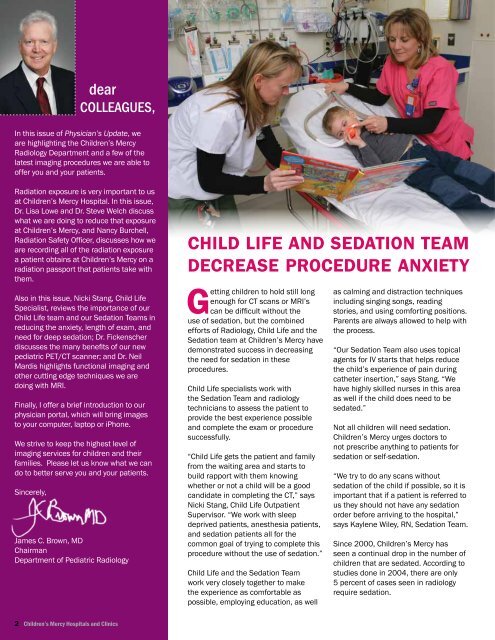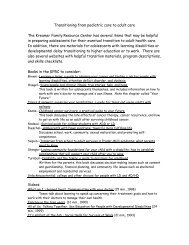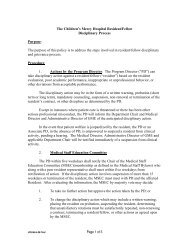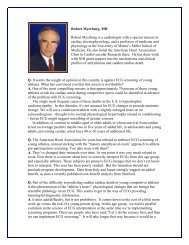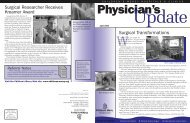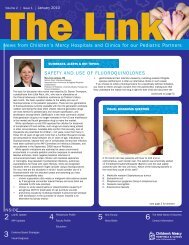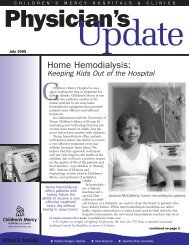Pediatric Imaging - Children's Mercy Hospitals and Clinics
Pediatric Imaging - Children's Mercy Hospitals and Clinics
Pediatric Imaging - Children's Mercy Hospitals and Clinics
You also want an ePaper? Increase the reach of your titles
YUMPU automatically turns print PDFs into web optimized ePapers that Google loves.
dearCOLLEAGUES,In this issue of Physician’s Update, weare highlighting the Children’s <strong>Mercy</strong>Radiology Department <strong>and</strong> a few of thelatest imaging procedures we are able tooffer you <strong>and</strong> your patients.Radiation exposure is very important to usat Children’s <strong>Mercy</strong> Hospital. In this issue,Dr. Lisa Lowe <strong>and</strong> Dr. Steve Welch discusswhat we are doing to reduce that exposureat Children’s <strong>Mercy</strong>, <strong>and</strong> Nancy Burchell,Radiation Safety Officer, discusses how weare recording all of the radiation exposurea patient obtains at Children’s <strong>Mercy</strong> on aradiation passport that patients take withthem.Also in this issue, Nicki Stang, Child LifeSpecialist, reviews the importance of ourChild Life team <strong>and</strong> our Sedation Teams inreducing the anxiety, length of exam, <strong>and</strong>need for deep sedation; Dr. Fickenscherdiscusses the many benefits of our newpediatric PET/CT scanner; <strong>and</strong> Dr. NeilMardis highlights functional imaging <strong>and</strong>other cutting edge techniques we aredoing with MRI.Finally, I offer a brief introduction to ourphysician portal, which will bring imagesto your computer, laptop or iPhone.We strive to keep the highest level ofimaging services for children <strong>and</strong> theirfamilies. Please let us know what we c<strong>and</strong>o to better serve you <strong>and</strong> your patients.Sincerely,James C. Brown, MDChairmanDepartment of <strong>Pediatric</strong> RadiologyChild Life <strong>and</strong> Sedation TeamDecrease Procedure AnxietyGetting children to hold still longenough for CT scans or MRI’scan be difficult without theuse of sedation, but the combinedefforts of Radiology, Child Life <strong>and</strong> theSedation team at Children’s <strong>Mercy</strong> havedemonstrated success in decreasingthe need for sedation in theseprocedures.Child Life specialists work withthe Sedation Team <strong>and</strong> radiologytechnicians to assess the patient toprovide the best experience possible<strong>and</strong> complete the exam or proceduresuccessfully.“Child Life gets the patient <strong>and</strong> familyfrom the waiting area <strong>and</strong> starts tobuild rapport with them knowingwhether or not a child will be a goodc<strong>and</strong>idate in completing the CT,” saysNicki Stang, Child Life OutpatientSupervisor. “We work with sleepdeprived patients, anesthesia patients,<strong>and</strong> sedation patients all for thecommon goal of trying to complete thisprocedure without the use of sedation.”Child Life <strong>and</strong> the Sedation Teamwork very closely together to makethe experience as comfortable aspossible, employing education, as wellas calming <strong>and</strong> distraction techniquesincluding singing songs, readingstories, <strong>and</strong> using comforting positions.Parents are always allowed to help withthe process.“Our Sedation Team also uses topicalagents for IV starts that helps reducethe child’s experience of pain duringcatheter insertion,” says Stang. “Wehave highly skilled nurses in this areaas well if the child does need to besedated.”Not all children will need sedation.Children’s <strong>Mercy</strong> urges doctors tonot prescribe anything to patients forsedation or self-sedation.“We try to do any scans withoutsedation of the child if possible, so it isimportant that if a patient is referred tous they should not have any sedationorder before arriving to the hospital,”says Kaylene Wiley, RN, Sedation Team.Since 2000, Children’s <strong>Mercy</strong> hasseen a continual drop in the number ofchildren that are sedated. According tostudies done in 2004, there are only5 percent of cases seen in radiologyrequire sedation.


